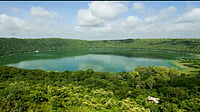Look for a guy called Sonam in Sagnam village,” a friend had told me. “He knows trekking routes in Pin Valley and will probably help you find a tent for your trek.” I had initially thought I would use Kaza, Spiti’s major town, as a stopover point to Pin Valley for some high-altitude trekking, but ended up staying longer. I had gotten greedy and stayed on a few hours longer to watch the Dalai Lama’s delightful birthday celebrations, missing the last bus to Sagnam.
I now had to make a decision in the cold twilight. There were no taxis or jeeps; the only way out was on the back of a pickup truck headed to Gulling, several kilometres away from Sagnam, but at least it was in the same direction. I got on.
My otherwise fantastic view of the mountainscape in silhouette was negated in part by four local rowdy teenage co-passengers, who would catcall obscenities and local equivalents of ‘hey sexy’ at girls and young women we passed. Many of these girls didn’t hear them too well, and just innocently waved back smiling, inadvertently neutralising the vulgar designs in the process, infuriating the already frustrated adolescents even more. It was both arbitrary and hopeless.
The boys, by the way, were artists at a nearby Buddhist monastery, who, as conversation developed, told me they hated life in a land without trees. “But you have all this,” I wanted to say, citing the majestic dry peaks, open country and Tantric Buddhism, but didn’t begin; my romantic ideas about Himachal Pradesh’s remote tribal areas had dried up and powdered away, like most things here eventually did. I wanted to climb a hill and be far away from people.
By the time I reached the sparsely populated village of Gulling, it was too dark to consider walking to Sagnam with a backpack. It turned out that a man named Sonam who worked in Sagnam lived there. I had been on a lucky streak so far during my travels in the Himalayas; it was certainly worth a try. But it turned out that this Sonam was a schoolteacher, not the guide I was looking for. I had run out of luck. Or maybe not…
“Since you’re here, why don’t you come in?” the ‘new’ Sonam suggested. The random hospitality caught me off guard, but it was too promising to refuse. We proceeded to a large kitchen, around which all family activity apparently centred. Kitchens in Spiti also multitask as living and dining rooms, where guests are entertained. It is customary to openly display all utensils. We sat on layers of rugs by long, low stools, drank barley arak, ate freshly made rotis with delicious warm lamb stew, and chatted till late in the night.
Sonam eventually suggested that I stay the night. He expected neither thanks nor appreciation in return, and brushed off my gratitude nonchalantly… He was completely unaffected by it, sometimes ignoring it altogether. It was generosity in its purest form.
Another guest was the mason who was working on renovating Sonam’s house. The custom here is interesting: the mason stays with the owner of the house till the job is done, and eats and drinks with the family every night, almost becoming part of the household during that period; it is easy to mistake him for a family member. Another noteworthy social dynamic: the whole village pitches in to help build each new home.
With some faith in humanity restored, I began the 4km walk through dry countryside on a rough road, dotted with colourful floral outbursts, to Sagnam, where I found the ‘real’ Sonam, who was not as interesting as the ‘wrong’ one. He directed me to a tent, with a guide named Phunchok attached. We took the evening bus to spend the night in a guesthouse in Mud (pronounced ‘Moodh’), a quaint village by the Pin River where the motorable road ends. This is where the real trekking begins…
DAY 1: Mud to Bada Boldhor
The walk from Mud to the first campsite was relatively easy, though we had to walk against a strong wind for a while. The weather has been splendid, the landscape dramatic. Pin Valley is a high-altitude cold desert, with no trees, and very little vegetation, most of it alpine scrub. But the rivers, especially the Pin and its tributaries, roar, and bright flowers colour their banks. Most mountains here are stark and dry; huge boulders cluster precariously on the rock face, like avalanches frozen in time. Others are bright bubblegum pink, daubed green in patches by dry alpine scrub vegetation, their gushing cascades and streams miniaturised to white threads by distance. Even the sun had a full circle rainbow around it.
Phunchok, my guide, has only done two treks in his entire life, several times over, but at least this was one of them. And he had a tent. He likes to take a lot of breaks, and finally fell asleep at 5pm. We have camped at a particularly green patch near the river, where a horseman has brought his Chhumurthi horses and their foals to graze. I am thirsty, and the water in the bottle sitting next to me in the tent is looking murky. I wonder if I will get desperate enough to drink it.
DAY 2: Boldhor to Phyiti, through the Bhabha Pass
The night was very cold. The murky water became morning chai and two-minute noodle soup, and strangely didn’t taste odd or gritty at all. I would need all the minerals I could get for the climb that would follow. Regulating breathing and tempo helped breathe the rarefied air, and we crossed the snowline in a couple of hours. We were approaching the icy source of the desert river on a steep gradient. Ahead stood the intimidating Bhabha Pass, like a white fortress, and above it a dense cloud. We walked into a blast of strong, freezing wind. It then began to rain and snow simultaneously, as if walking on snow with flimsy shoes weren’t enough. A jacket protected my upper body from the rain, but soaked me in sweat from the inside as I fought the wind and gravity and tried to walk in snow, which soon found its way into my shoes.
Phunchok, who had seemed more or less at par with me in terms of stamina, now had the upper hand. He strangely didn’t think of lending it to me, as I skidded and slipped through snow, into which I would occasionally sink knee-deep. He would walk far ahead, wait blinking on a rock, watching. Just before I could reach and ask him to slow down, he would vanish again.
It was almost funny.
Whenever the going got tough or my once latent asthmatic bronchitis acted up or stupid footwear threatened to give way, I looked at the snow patterns, felt the icy mist on my face, and was reminded that this was one of the most beautiful sights I had ever seen. It was a great confidence lifter, and yet humbling.
There was a point when it suddenly got cloudy, even colder and everything was white — ground, air and sky. My guide walked far ahead and faded into it. A peculiar situation: Did it feel infinite or void-like? Which way is up in a white world?
“Shut up and focus, focus!”
Descending to a less interesting version of normality, I returned to my lot, found my way somehow, reduced to something of a bronchial mess, and reached my so-called guide.
When the clouds cleared on the other side of the Bhabha Pass, I had my first glimpse of Kinnaur. No trees still, but rivers roared through vivid, velvety green mountains, some light drizzle… The progression from Pin Valley was extreme. It took about seven hours to reach our campsite at Phyiti.
DAY 3: Phyiti to Langbuk
It is only on closer inspection that the green on the slopes is seen as a carpet of lush dwarf shrubs peppered with a multitude of red, electric blue and yellow flowers, making it an even more spectacular sight at ground level.
Near Boldhor I met Kinnauri gaddis, nomadic shepherds who roam the mountains, often covering hundreds of kilometres on their circuits. They are generally friendly and fun-loving, and proudly wear their traditional costumes and distinctive Kinnauri caps. In the summer, they visit these slopes to gather a special bark used to make high quality incense. Lunching with one such family broke the monotony of instant noodles and salty Tibetan tea.
After crossing the tree line, the landscape began to transform yet again… From flower-dotted valleys graduating to sparse conifer groves, then grassy, and then thicker alpine woods. At our campsite at Langbuk I met the only other trekkers on the route — an Israeli guy and two European women who had met in Kinnaur and were doing the same trek in the reverse direction. They had built a ‘tent’ out of blue plastic sheet and hired a horseman, along with his two horses to carry luggage. A whacky old Kinnauri shepherd accompanied them, gulping occasionally from a hip flask. When he wasn’t bouncing to the tunes of Israeli pop music on the Walkman, he was teaching the girls to knit mufflers.
“And where did you pick him up?” I asked. “It’s more like he picked us up,” said one of the girls, evidently enjoying the knitting lesson and the surrealism of it all. We found ourselves laughing uncontrollably. The shepherd joined in.
DAY 4: Langbuk to Kafnu
My first sight in the morning — a whole extended family of gaddis, and their furry mountain goats eagerly waiting outside my tent to pose for a group photograph. This took much longer than I expected; it wasn’t easy getting only one of them to talk at a time and the rest to shut up, and keeping people from arbitrarily escaping from the frame once they began to pose.
The views improved as I descended towards Kafnu through thicker, more fragrant woods. The weather got warmer; the tingly drizzle on my face, flowers, butterflies, songbirds, fragrance of the pines and noticeably higher oxygen levels made it feel like ‘regular’ hiking again. My backpack felt lighter.
Kinnaur is really too dreamlike for words, but for the people who live here, it comes at a price — severe winters, when temperatures can drop to minus 30 degrees. Many road routes close; people just stay indoors, drink and wait for better weather. Winter is also the best time to spot the elusive snow leopard, easily the most beautiful animal in these parts.
It took us about five hours to reach Kafnu, a charming little Kinnauri town and site of a big hydroelectric project. Sitting by the dam, I could finally begin to digest the extreme changes over the last four days. Pin Valley’s rugged treeless cold desert, the great Bhabha Pass molestation, Kinnaur’s green alpine meadows and pine forests, all the mood swings and high-altitude madness that I could now relate with the extreme changes in altitude, landscape and all the colourful people I had met on the way. Yet, there was much more to it…
With a new appreciation for regular things — people, trees, good weather, oxygen and all the things we take for granted, I moved on, looking forward to the next trek.
This article is from our archives. It was first published in 2014























